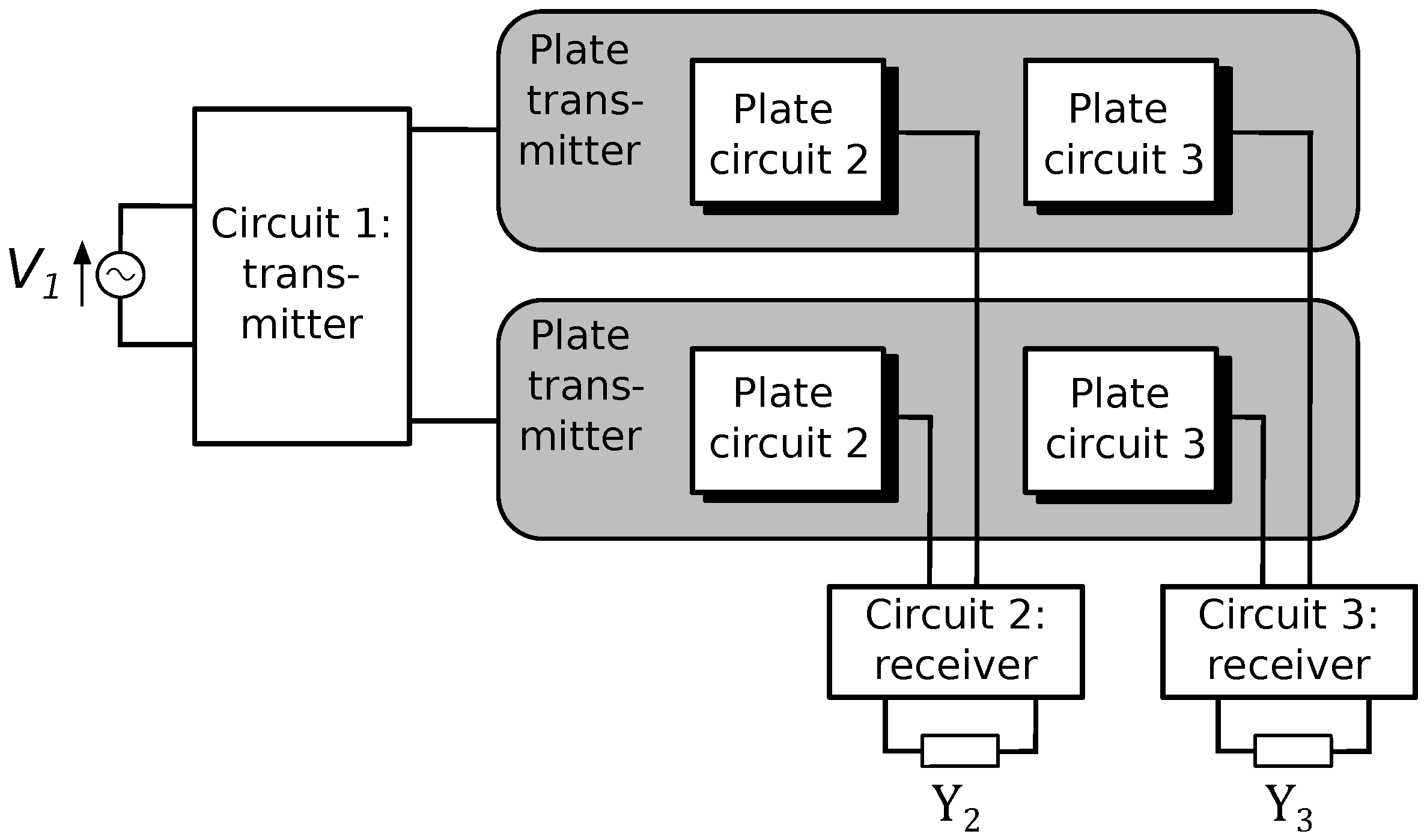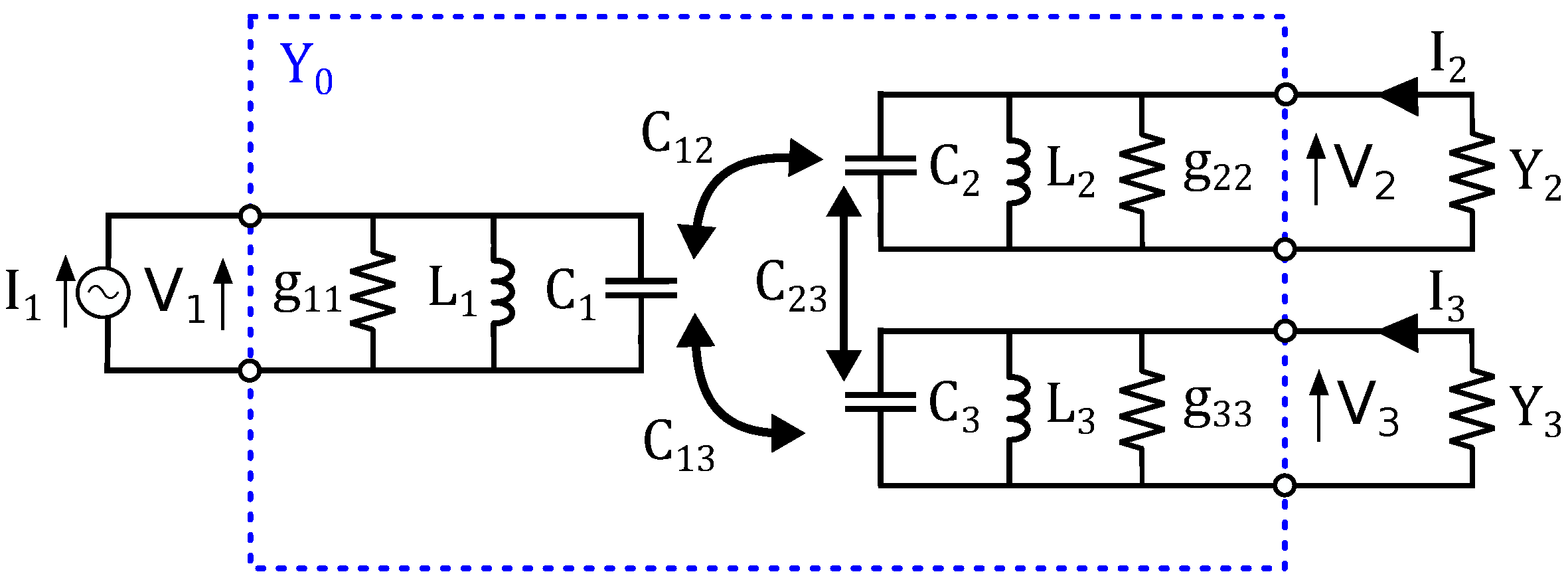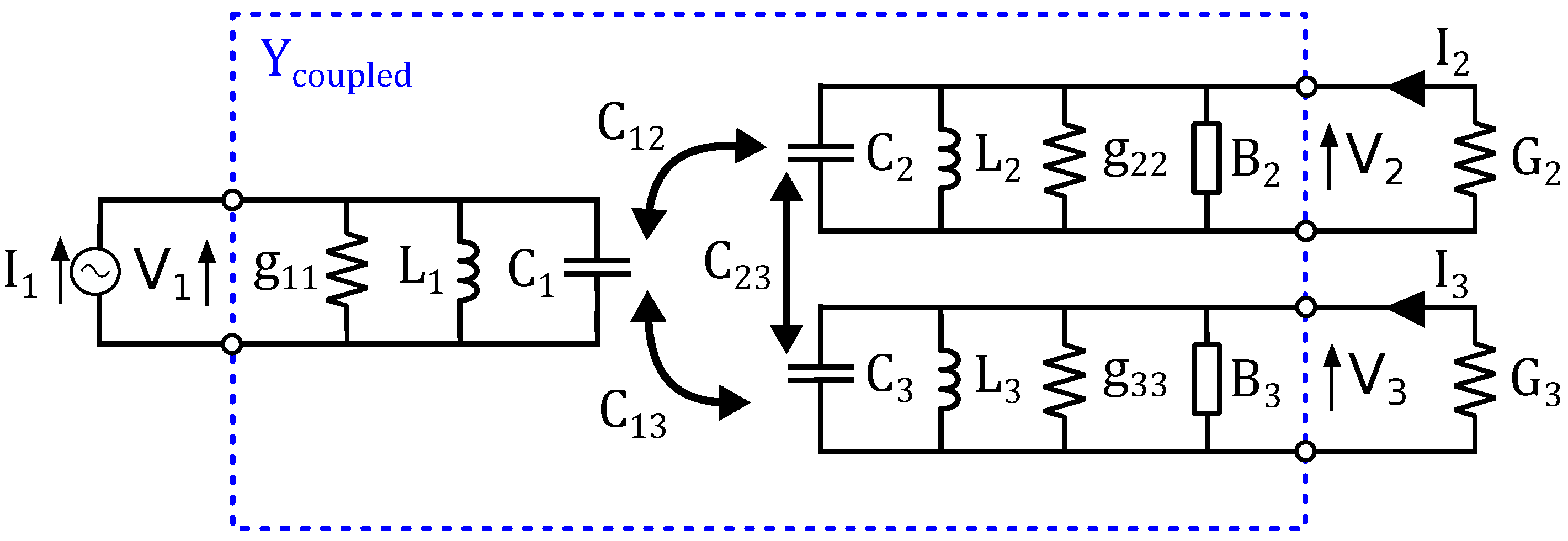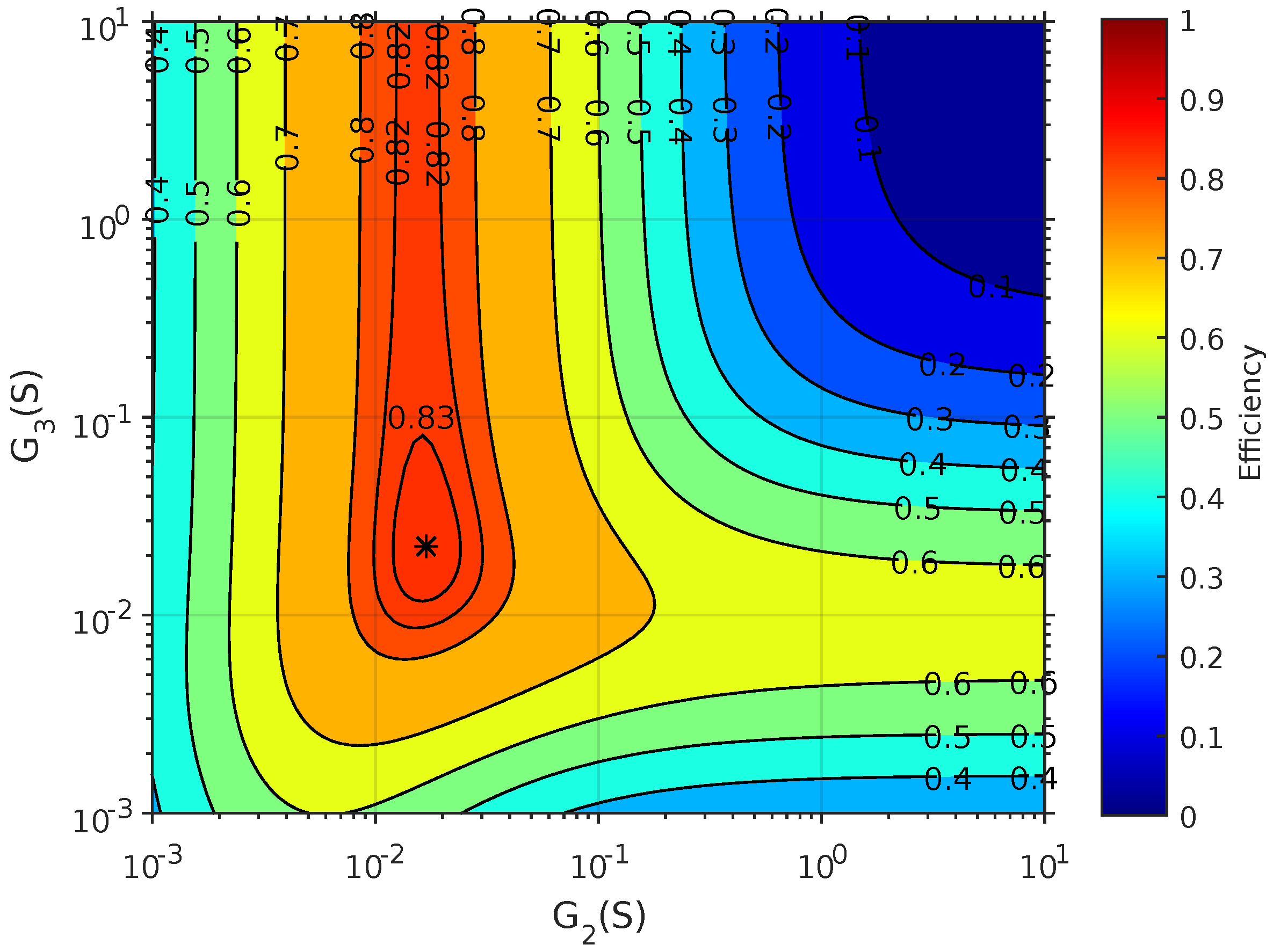In this section, we first numerically verify our results. Next, we analyze the maximum power and maximum efficiency solution in more detail, and illustrate the similarities with IWPT.
3.1. Numerical Verification
First, we notice that, if one receiver is absent or uncoupled (e.g.,
), the results of
Table 1 correspond to the solutions for a CWPT system with one transmitter and one receiver [
16].
We now verify the above analytical derivation by circuit simulation. We consider the system of
Figure 2 with one transmitter and two capacitive coupled receivers. If we assume a system composed of a large aluminum transmitter with aluminum receiver plates of 10 cm × 10 cm, coated with polyethylene as a dielectric material, at a distance of 2.5 mm between transmitter and receiver, we can assume the representative values of
Table 2 [
14,
24].
Using Equations (
1), (
2), and (
10)–(
12), the values of the coupling factors, resonance inductances, and auxiliary variables are calculated (
Table 3).
We first verify the optimal loads for the maximum power configuration. From
Table 1, we calculate the following:
The optimal loads and for achieving maximum power transfer.
The capacitances and , necessary to compensate for the coupling between both receivers.
The corresponding normalized input and output power.
The efficiency of the system.
The calculated values are listed in
Table 4.
This system was simulated in SPICE for varying loads
and
.
Figure 4 shows the normalized power output
. A maximum
of 0.992 was obtained at the loads
and
of 189 and 252 mS, respectively. This was in accordance with the analytical result from
Table 4. Additionally, the obtained efficiency
of 49.2% at this point corresponded with the analytical calculated value.
Secondly, we consider the maximum efficiency configuration for the same system. From
Table 1, we find the values listed in
Table 4. By SPICE simulation, we calculated the efficiency of the system for varying loads
and
(
Figure 5). A maximum efficiency
of 83.6% was achieved at the loads
and
of 16.8 and 22.5 mS, respectively, which was in accordance with the analytical derived result. The corresponding normalized output power
was 0.298, corresponding with the expected value (
Table 4).
Finally, we verify that the calculated values of the capacitances
and
indeed compensate for the coupling between the receivers. We simulated both the maximum power and the maximum efficiency configuration for the uncoupled configuration; we considered the same system as described by
Table 2, but now with
equal to zero and no compensating capacitances
and
present. We obtained the same calculated values of the coupled scenario (
Table 3 and
Table 4). Circuit simulations with SPICE produced the same results as in
Figure 4 and
Figure 5, indicating that
and
indeed compensate for the coupling between the receivers.
3.2. Analysis of the Results
From
Table 1, it can be seen that the optimal conductances for the maximum power configuration are always larger than for the maximum efficiency configuration, as
. Additionally, the normalized input power
is higher in the maximum power scenario than in the maximum efficiency scenario. From
Figure 4 and
Figure 5, it can be seen that for the numerical example, both the output power and efficiency are near the maximum, which varies more when changing
than when changing
. The reason is that the coupling between the transmitter and the first receiver is higher than the coupling between the transmitter and the second receiver. A further, more detailed analysis is beyond the scope of this work.
In our numerical example, the coupling factor between both receivers is 22%, that is, . We demonstrated that capacitances and are necessary to compensate for this coupling between the receivers.
We illustrate the influence of the presence of these compensating capacitances with an example. We calculate the normalized output power and the efficiency for non-ideal loads of = 1 mS and = 10 mS. The normalized output power with compensating capacitances and is 0.0376. If no compensating capacitances are present, is 0.0246, about 7% lower. The efficiency with and without compensating capacitances is 50.8% and 41.5%, respectively, an absolute difference of 9.3%.
In the neighborhood of the maximum power point and maximum efficiency point, the difference between and , respectively, is negligible for the circuit with and without compensating capacitances for this example.
An important limitation of our proposed model is that it is restricted to static CWPT set-ups. The model assumes that all elements, including the coupled capacitances, are lumped elements and are fixed, whereas in reality, the capacitances are distributed elements and are dependent on the position of the receivers. For the implementation of our model, the values of the capacitances and coupling coefficients can be determined by measurement [
24]. However, these values are not fixed. Indeed, the values of the capacitances and coupling coefficients are not independent of each other [
24]. For example, a change in the position of one receiver will not only influence the coupling coefficients for that receiver, but also the values of the capacitances. Even the value of the capacitance
of the transmitter and the value of the coupling coefficient between the transmitter and the second receiver can vary as a result of the change in position of the first receiver. This implies that our model is only valid for static applications, for example, the charging of space-confined systems, such as low-power consumer applications [
12] or three-dimensional integrated circuits [
11], for which the receivers have predefined locations. For moving receivers, such as electric vehicles [
26], robot arms and in-track-moving systems [
12], our model is not valid. For future work, we plan to extend our model by applying distributed elements.
3.3. Duality to IWPT
Given the duality principle in network theory [
25], which finds its origin in the symmetry of Maxwell’s equation for the electric and magnetic fields, parallels can be drawn between CWPT and IWPT.
Table 5 gives an overview of the relevant dual quantities for CWPT and IWPT.
The dual network of
Figure 3 is given in
Figure 6. A transmitter is supplied by a voltage source
. The inductances
(
i = 1,2,3) are coupled and expressed by their mutual inductance
; the coupling factor
is defined as
The loads of the two receivers are and . Resonance capacitors and resistances (i = 1,2,3) are added in series to each circuit. The reactances and compensate for the coupling between and . Just as for the CWPT set-up, this circuit is limited to static set-ups and does not include, for example, the leakage flux in the primary circuit.
Given the duality principle, we can for IWPT define the following analogous variables:
With these definitions and by applying the duality principle, we obtain the quantities of
Table 6, analogous to in [
17,
18,
19]. We notice the similarities for the corresponding quantities for CWPT in
Table 1. For example, the load conductance
for CWPT is given by
and
for the maximum power and efficiency configuration, respectively. The dual load for IWPT, the resistance
, is given by
and
for the maximum power and efficiency configuration, respectively, which corresponds to the dual values of CWPT. Analogously, for CWPT, the elements that compensate for the receiver’s coupling are susceptances, whereas for IWPT, they are reactance elements given by the same, but dual, expressions of CWPT.











